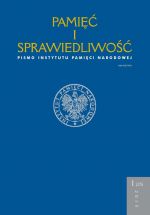Życie i śmierć Żydów z Zachodniego Wołynia (1921–1945)
The Life and Death of Jewry in Western Volhynia, 1921–1945
Author(s): Timothy SnyderSubject(s): History, Jewish studies, Recent History (1900 till today), History of Judaism
Published by: Instytut Pamięci Narodowej
Keywords: Volhynia; Jews; the Second Republic of Poland; World War Two; ghetto; communism
Summary/Abstract: This article presents the characteristics of the Jewish population living in Western Volhyniain the times of the Second Republic of Poland and during the Second World War. Polishinterwar authorities enabled the Jewish communities to follow their traditional pattern of life. With time, however, Zionism and especially communism were becoming increasingly popular among the Volhynian Jews. In 1937, the Jewish community accounted for about 10 percent of the region’ s inhabitants and was outnumbered by the Ukrainian minority. Jews dominated in trade and skilled crafts and constituted half of the urban population. After 17 September 1939, Volhynia found itself under Soviet occupation. Initially, the Red Army was welcome, as the Soviet terror was mostly directed against the Polish population. Due to aggressive sovietisation, however, the Jews of Volhynia lost any illusions as to the possibility of achieving autonomy, realizing that they had simply become citizens of a totalitarian state.Their situation deteriorated dramatically in June 1941 following the German invasion of Russia. In accordance with Nazi ideology, the local Jews were to be exterminated in the Holocaust. In June and July 1941 alone, approximately 12 000 Jews were murdered by the Germans on the front lines of the war, in the autumn – 20 000 more. The collaborating Ukrainian police forces helped the German occupiers in inflicting terror. The Germans began to set up ghettos at the end of 1941, only to start their liquidation several months later. Jews were murdered on a massive scale in the so-called death pits near their homes. Most of the Volhynian Jews lost their lives during the war. Only a few managed to escape or found shelter among Poles or Ukrainians. Some decided to join partisan groups (mostly communist), who conducted their operations in the extremely difficult conditions of German occupation, Soviet counter-offensive and ethnic civil war in Volhynia.
Journal: Pamięć i Sprawiedliwość.
- Issue Year: 25/2015
- Issue No: 1
- Page Range: 243-275
- Page Count: 33
- Language: Polish

